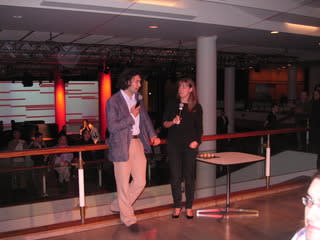たった今、ユロフスキ指揮のロンドン・フィルハーモーニック・オーケストラのシーズン・オープニング・コンサートから帰ってきた。
素晴らしい演奏会だった。既に終了後、1時間半が経過しているが、未だ高ぶった気持ちと心臓の鼓動が収まらない。
良い演奏会になる予感はあった。今日のメインのマーラーの交響曲第2番だが、今年6月にこのコンビで、Todtenfeierというこの交響曲第2番の第一楽章の元となった曲を演奏しているが、それが素晴らしかったからである。
しかし、実際はその期待を遥かに上回るものであった。ユロフスキのメリハリののつけかた、スロー・ハイを織り交ぜた絶妙のテンポ、気合の入った弦、ホールに響き渡る管、打楽器の爆発、コーラスの清らかさ、独唱の深み、全てが絶妙に組み合わさったケミストリーを構成していた。聴いていて、胸が高鳴り、背筋が伸び、時には涙が出てくる。生と死をテーマにする、マーラーの音楽の精神性が高く表現されていたと思う。
今日は団員の気合の入り方が本当にひしひしと伝わってきた。楽譜も読めない私が、コンサートで注目しているのは、団員の気合の入り方。演奏中はもちろんだがが、団員の気合は演奏していない時の目つき、態度に表れると思って、いつも注目している。今日の、LPOの団員は誰もが、次の出番を待つ緊張感と集中力に溢れていた。プロといえども、姿勢や態度は本当に正直に「気」を表すのである。(ベンチでのイチローと清原の違いを見れば一目瞭然)
そういった意味で一つだけ残念だったこと。ソプラノのAdriana Kucerova。プロムスのフィデリオにも出ていて、美人だし、歌唱力も素晴らしい。しかし、出番を待つときの態度が最低だ。足を組み、時に周りを見渡し、不敵な笑みを浮かべたりして、いかにも「私がこの舞台の主役よ」と言わんばかりの高慢な態度。隣のメゾソプラノ氏が両膝をしっかりそろえて、視点を一点に見つめ出番を真摯に待っていたので、なおさらその態度のでかさが鼻につく。無視したいのだが、ユロフスキのすぐ前に座っているので、いやでも見えてしまう。あの態度だけは本当に改めたほうが良いと思う。
人の悪口をこれ以上書くと、語るに落ちるのでやめておくが、とにかくコンサートは素晴らしかった。こちらに来てから、これまでにないペースで演奏会に出かけているが、間違いなくトップ3に入るような記憶に残る演奏だった。
写真等はまた後日アップしたい。明日はハーフマラソンに出走するが、このまま寝られるのだろうか?
2009年9月26日 23:38記
26 September 2009 7:30pm
Opening of the season in the Royal Festival Hall
Vladimir Jurowski conductor
Adriana Kucerova soprano
Christianne Stotijn mezzo soprano
London Philharmonic Choir
Kurtág Stele
Mahler Symphony 2
※9月27日写真追加
1曲目のKurtágが終わった後。私は結構良かったかと思ったけど、会場は惑いの拍手で、残念ながらカーテンコールもなし。皆、次の「復活」が待ち遠しい様子。

「復活」終了後のカーテンコール。大拍手の前に左から合唱指揮の人、ユロフスキ、Stotijn、Kucerova。

後ろに写っているコーラスも素晴らしかったです。

コンサート終了後のイベント。ユロフスキとのインフォーマル・ディスカッション。100名を超える人が集まり、マーラーについてや今日の演奏について質疑応答が行われました。

From The Times
September 29, 2009
London Philharmonic Orchestra/Jurowski at the Festival Hall, SE1
Geoff Brown
*****
The attraction of Mahler’s Resurrection Symphony seems without end. Every week one major orchestra or another throws itself into trudging death, shrieking anguish and life’s memories bitter and fond, before resurrection trumpets, choir and soprano soloists waft everyone into immortality. The result is always a full house: in this fretful age we’d all like to be transfigured.
Performances, though, don’t always match aspirations. That wasn’t the case with Vladimir Jurowski’s spellbinding concert on Saturday with the London Philharmonic. First, he cleared the ears with György Kurtág’s Stele, a compressed, elegiac miracle of juddering chords, microtonal haze and questioning phrases, very precisely steered. Then we jumped back 100 years, to Mahler’s own elegies and modernities. Jurowski’s handling of the opening funeral march brushed against the ordinary, but the fluid transitions from mood to mood, the clarity of the orchestra’s textures, still made the ears stand up.
The wonders quickly intensified after Mahler’s proscribed lengthy pause, when the London Philharmonic Choir filed on as though rehearsing the Dead March from Saul. This gave a clue about what was to follow, for Jurowski pondered the andante’s bittersweet recollections at a speed slow enough to be daring. Even so, the drowsy strings still kept their lilt, while the theme’s final reprise sweetly suggested old age amused by love’s young dreams.
One drum thwack, and the balloon was pricked. Time for that disturbed, merry-go-roundLondon Philharmonis Orchestra/Jurowski scherzo: another movement lifted far from the routine by Jurowski’s freshly considered pacing and phrasing and the LPO’s gleaming colours. Chistianne Stotijn’s milky mezzo brought its own beauties in her Urlicht movement. Then it was resurrection time. Jurowski wasn’t one for the quick fix. Once again pace slowed, with an unusually measured choral delivery of Klopstock’s lines, brightly decorated by Adriana Kucerová’s golden soprano. It’s not easy for any large amateur choir to maintain radiance and pitch in hushed tones for minutes on end; but Neville Creed’s forces triumphed. Were we transfigured? Definitely.
素晴らしい演奏会だった。既に終了後、1時間半が経過しているが、未だ高ぶった気持ちと心臓の鼓動が収まらない。
良い演奏会になる予感はあった。今日のメインのマーラーの交響曲第2番だが、今年6月にこのコンビで、Todtenfeierというこの交響曲第2番の第一楽章の元となった曲を演奏しているが、それが素晴らしかったからである。
しかし、実際はその期待を遥かに上回るものであった。ユロフスキのメリハリののつけかた、スロー・ハイを織り交ぜた絶妙のテンポ、気合の入った弦、ホールに響き渡る管、打楽器の爆発、コーラスの清らかさ、独唱の深み、全てが絶妙に組み合わさったケミストリーを構成していた。聴いていて、胸が高鳴り、背筋が伸び、時には涙が出てくる。生と死をテーマにする、マーラーの音楽の精神性が高く表現されていたと思う。
今日は団員の気合の入り方が本当にひしひしと伝わってきた。楽譜も読めない私が、コンサートで注目しているのは、団員の気合の入り方。演奏中はもちろんだがが、団員の気合は演奏していない時の目つき、態度に表れると思って、いつも注目している。今日の、LPOの団員は誰もが、次の出番を待つ緊張感と集中力に溢れていた。プロといえども、姿勢や態度は本当に正直に「気」を表すのである。(ベンチでのイチローと清原の違いを見れば一目瞭然)
そういった意味で一つだけ残念だったこと。ソプラノのAdriana Kucerova。プロムスのフィデリオにも出ていて、美人だし、歌唱力も素晴らしい。しかし、出番を待つときの態度が最低だ。足を組み、時に周りを見渡し、不敵な笑みを浮かべたりして、いかにも「私がこの舞台の主役よ」と言わんばかりの高慢な態度。隣のメゾソプラノ氏が両膝をしっかりそろえて、視点を一点に見つめ出番を真摯に待っていたので、なおさらその態度のでかさが鼻につく。無視したいのだが、ユロフスキのすぐ前に座っているので、いやでも見えてしまう。あの態度だけは本当に改めたほうが良いと思う。
人の悪口をこれ以上書くと、語るに落ちるのでやめておくが、とにかくコンサートは素晴らしかった。こちらに来てから、これまでにないペースで演奏会に出かけているが、間違いなくトップ3に入るような記憶に残る演奏だった。
写真等はまた後日アップしたい。明日はハーフマラソンに出走するが、このまま寝られるのだろうか?
2009年9月26日 23:38記
26 September 2009 7:30pm
Opening of the season in the Royal Festival Hall
Vladimir Jurowski conductor
Adriana Kucerova soprano
Christianne Stotijn mezzo soprano
London Philharmonic Choir
Kurtág Stele
Mahler Symphony 2
※9月27日写真追加
1曲目のKurtágが終わった後。私は結構良かったかと思ったけど、会場は惑いの拍手で、残念ながらカーテンコールもなし。皆、次の「復活」が待ち遠しい様子。

「復活」終了後のカーテンコール。大拍手の前に左から合唱指揮の人、ユロフスキ、Stotijn、Kucerova。

後ろに写っているコーラスも素晴らしかったです。

コンサート終了後のイベント。ユロフスキとのインフォーマル・ディスカッション。100名を超える人が集まり、マーラーについてや今日の演奏について質疑応答が行われました。

From The Times
September 29, 2009
London Philharmonic Orchestra/Jurowski at the Festival Hall, SE1
Geoff Brown
*****
The attraction of Mahler’s Resurrection Symphony seems without end. Every week one major orchestra or another throws itself into trudging death, shrieking anguish and life’s memories bitter and fond, before resurrection trumpets, choir and soprano soloists waft everyone into immortality. The result is always a full house: in this fretful age we’d all like to be transfigured.
Performances, though, don’t always match aspirations. That wasn’t the case with Vladimir Jurowski’s spellbinding concert on Saturday with the London Philharmonic. First, he cleared the ears with György Kurtág’s Stele, a compressed, elegiac miracle of juddering chords, microtonal haze and questioning phrases, very precisely steered. Then we jumped back 100 years, to Mahler’s own elegies and modernities. Jurowski’s handling of the opening funeral march brushed against the ordinary, but the fluid transitions from mood to mood, the clarity of the orchestra’s textures, still made the ears stand up.
The wonders quickly intensified after Mahler’s proscribed lengthy pause, when the London Philharmonic Choir filed on as though rehearsing the Dead March from Saul. This gave a clue about what was to follow, for Jurowski pondered the andante’s bittersweet recollections at a speed slow enough to be daring. Even so, the drowsy strings still kept their lilt, while the theme’s final reprise sweetly suggested old age amused by love’s young dreams.
One drum thwack, and the balloon was pricked. Time for that disturbed, merry-go-roundLondon Philharmonis Orchestra/Jurowski scherzo: another movement lifted far from the routine by Jurowski’s freshly considered pacing and phrasing and the LPO’s gleaming colours. Chistianne Stotijn’s milky mezzo brought its own beauties in her Urlicht movement. Then it was resurrection time. Jurowski wasn’t one for the quick fix. Once again pace slowed, with an unusually measured choral delivery of Klopstock’s lines, brightly decorated by Adriana Kucerová’s golden soprano. It’s not easy for any large amateur choir to maintain radiance and pitch in hushed tones for minutes on end; but Neville Creed’s forces triumphed. Were we transfigured? Definitely.















